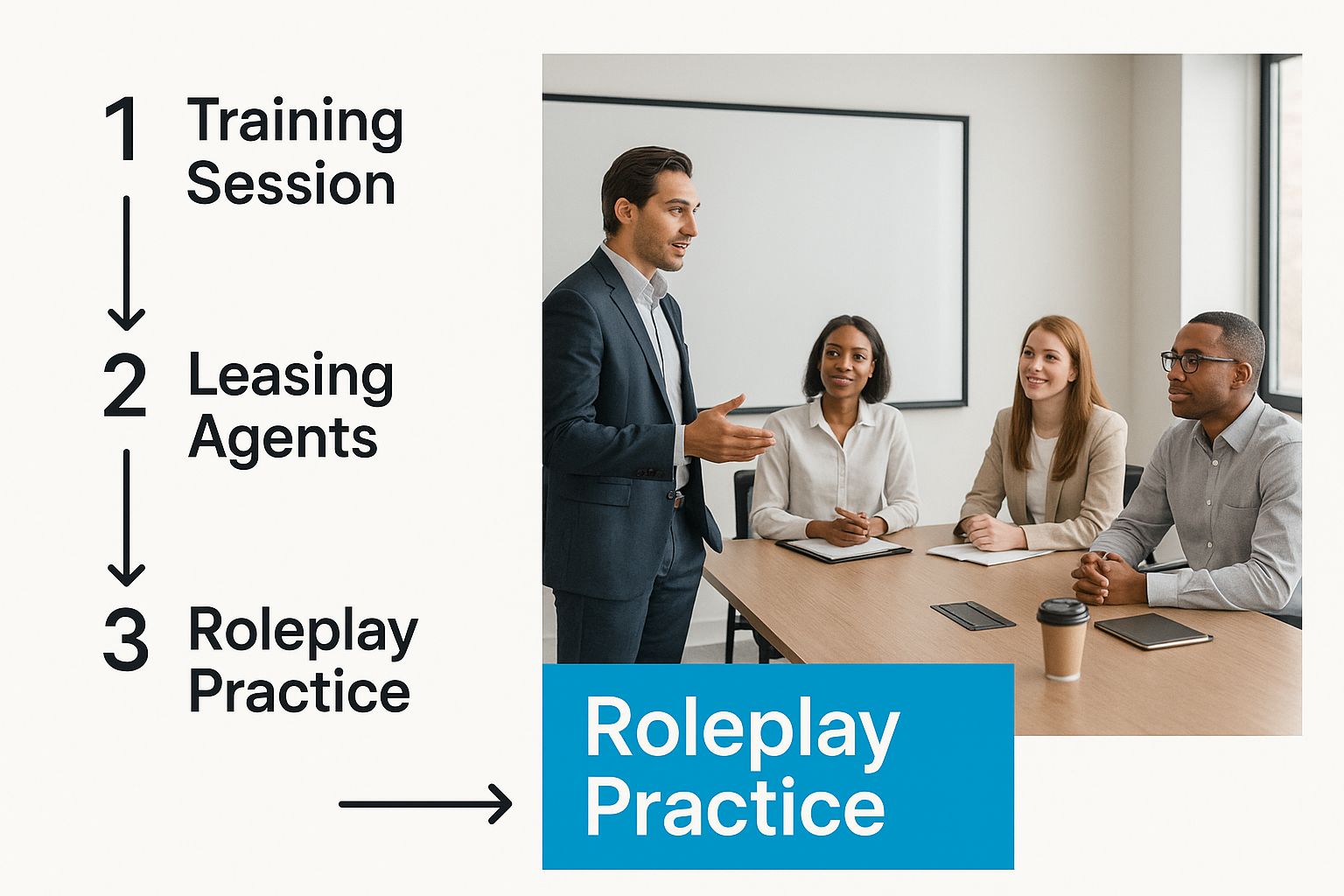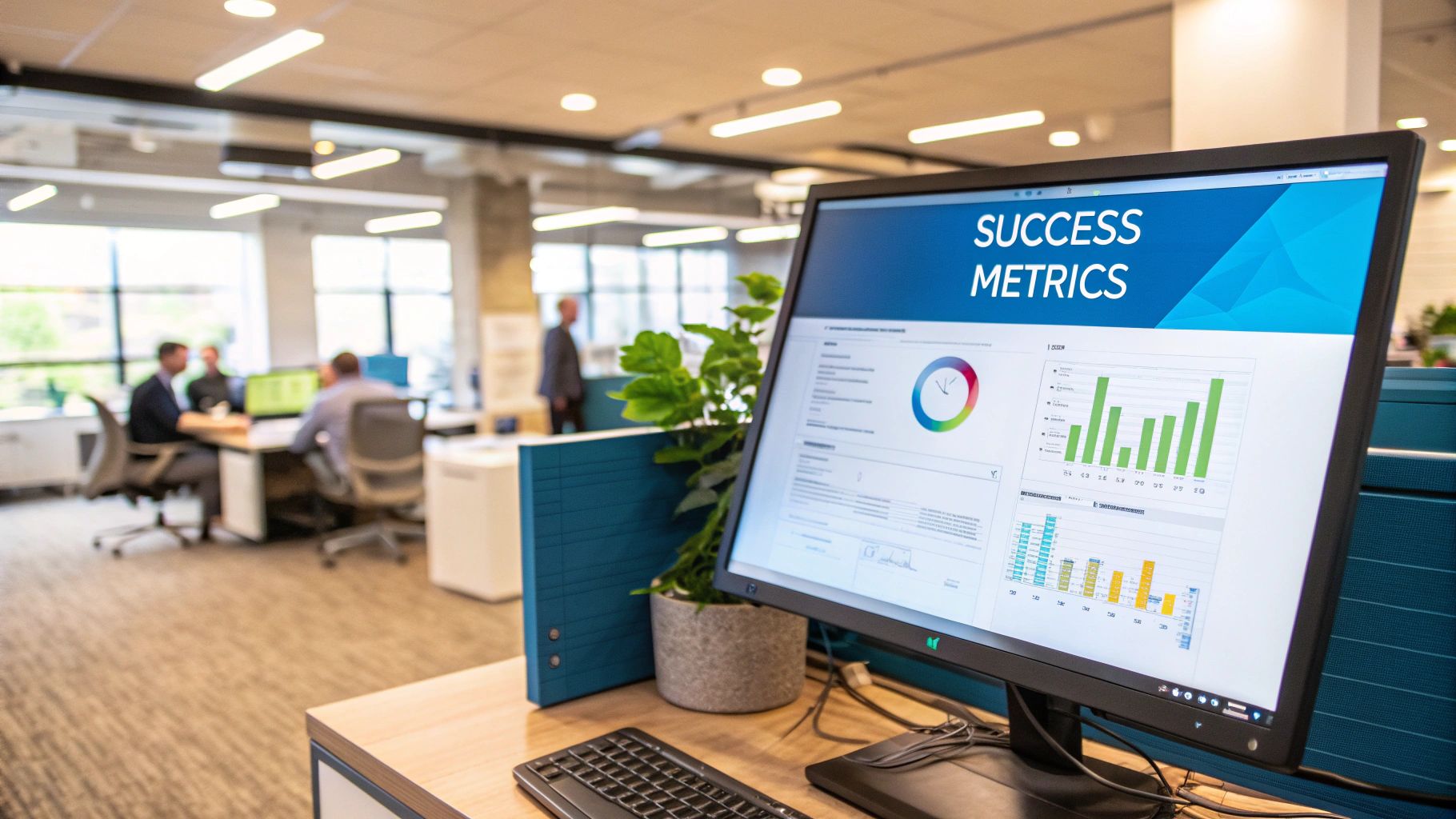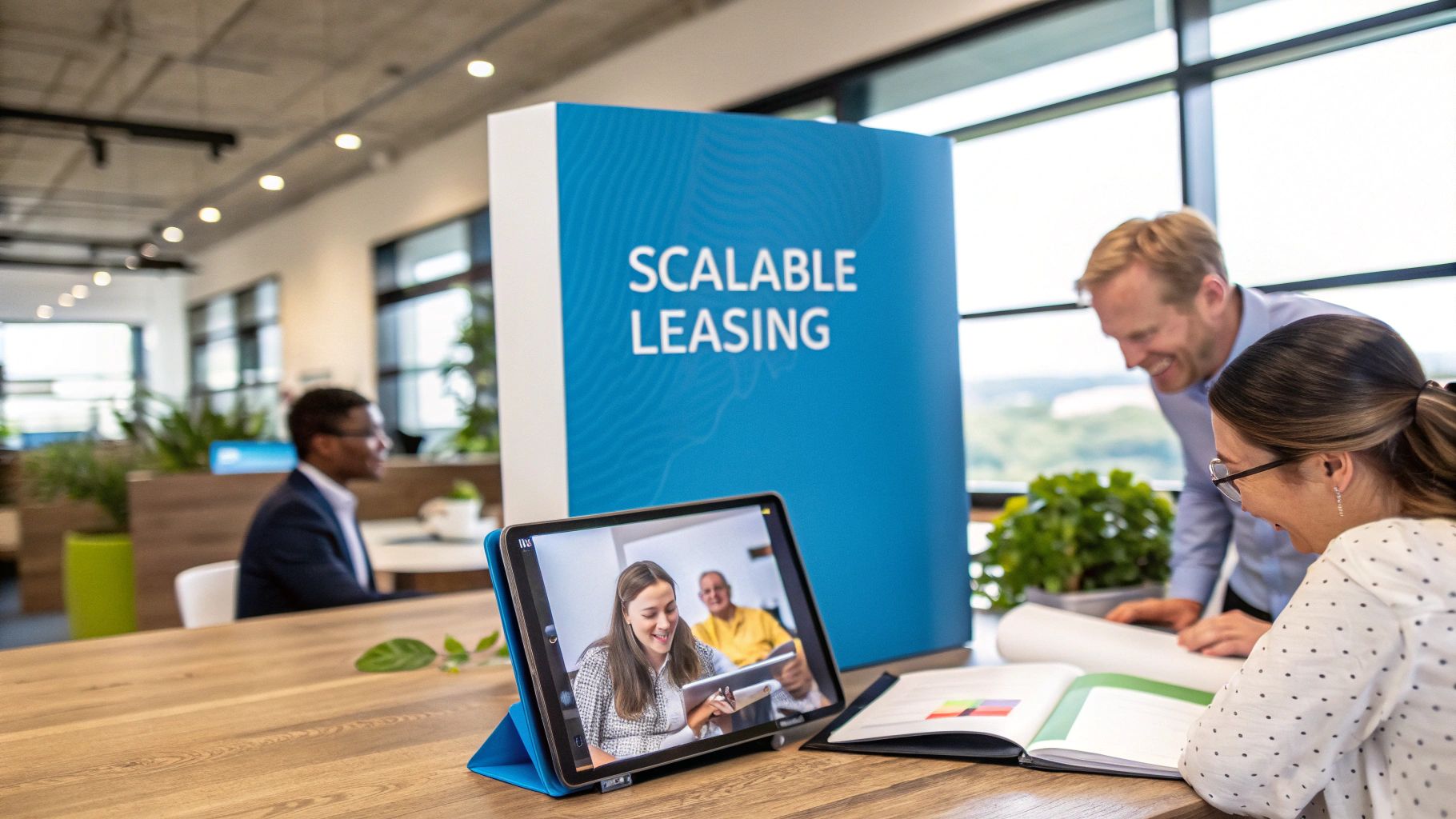For large-scale property management companies, the best leasing teams operate with speed and consistency, acutely aware that every vacant day is lost revenue. Effective leasing training isn't just an HR function; it's a core financial strategy engineered to standardize remote operations, dramatically reduce your speed-to-lease, and directly boost revenue by minimizing costly vacancy days across your entire portfolio.
Why Generic Leasing Training Fails at Scale

For property management companies managing hundreds or thousands of units across multiple markets, a "one-size-fits-all" training program is a recipe for operational failure. Standard, off-the-shelf courses that might suffice for a small, localized operation simply cannot build the high-speed, uniform processes required to manage at scale. This common mistake leads to inconsistent team performance, a poor lead-to-tour conversion rate, and a direct hit to your most critical financial KPIs.
When training isn't built around your specific workflows, your PropTech stack, and the unique challenges of a distributed portfolio, the problems compound quickly. You'll see it in your Days on Market (DOM) as inconsistent follow-up allows qualified leads to go cold. Every extra day a property sits vacant represents pure revenue loss—a cost that multiplies alarmingly across a large portfolio.
The Disconnect Between Training and Performance
The core issue is that generic training treats leasing as a checklist of tasks, failing to connect an agent's daily activities to the financial health of the portfolio. It completely misses the mark on what drives revenue for enterprise-scale operations.
A leasing training program that delivers measurable ROI must be built around the metrics that matter to portfolio managers:
- Speed-to-Lease: Training agents to respond, show, and close faster is the most direct lever to pull for reducing vacancy loss.
- Lead-to-Tour Conversion: Your team needs to master the scripts, systems, and speed necessary to convert every qualified inquiry into a scheduled showing.
- Cost Per Door: When leasing processes are efficient and standardized across every market, the operational cost per unit decreases, boosting overall portfolio profitability.
To illustrate the bottom-line impact, let's analyze how ineffective training erodes key operational metrics.
The True Cost of Ineffective Training on Portfolio KPIs
This table reveals the tangible operational drags and financial losses that result from inadequate leasing training in large-scale property management.
The data is clear. Ineffective training is a significant financial drain that actively works against your operational efficiency and growth goals.
A well-trained team doesn't just fill vacancies; they actively protect your bottom line. Investing in a strategic training framework is one of the highest-ROI decisions a large-scale property manager can make, directly influencing portfolio profitability and operational efficiency.
Shifting from an HR Checkbox to a Financial Strategy
Ultimately, you must stop viewing leasing training as a simple HR task and start seeing it as a pillar of your financial strategy. It’s not just about covering Fair Housing laws (though that's critical). It's about engineering a repeatable, measurable system that ensures every agent, in every market, executes the leasing process with the exact same speed and professionalism.
This is the strategic alignment that allows you to shrink your DOM, boost lead conversion rates, and achieve true operational control over your entire distributed portfolio. Without it, you’re leaving significant revenue on the table.
Building Your Foundational Leasing Curriculum
To eliminate inconsistent results, it's time to stop treating training as a one-off event. What you need is a solid, replicable leasing curriculum—an operational blueprint that ensures every new hire can quickly start impacting your core KPIs, like shrinking Days on Market (DOM) and boosting lead-to-tour conversions.
When managing hundreds or thousands of units across different markets, this level of consistency isn't just beneficial—it's non-negotiable for scalable growth.
The objective is to build a system so clear and effective that a new team member can become a productive, revenue-generating agent in days, not weeks. The most effective way to achieve this is by building your curriculum around the two pillars of scalable property management: your technology and your processes.
Mastering Your PropTech Stack
Your leasing team doesn’t just use software; they operate within a digital ecosystem designed for speed. Therefore, training must go beyond login credentials and focus on how each tool integrates to accelerate the entire leasing cycle.
Your foundational tech training should drill down on:
- Property Management System (PMS): Focus on the exact workflows for updating unit availability, executing dynamic pricing strategies, and processing applications. Your team must understand how PMS data syncs with marketing channels to ensure 100% accuracy.
- Customer Relationship Management (CRM): This is your lead management engine. Training means mastering lead source tracking, setting up automated follow-up sequences for speed-to-lead, and documenting every prospect interaction to maintain a complete communication history.
- Showing Software: Agents must become experts at scheduling, managing tour logistics, and logging feedback instantly. For remote-first operations, this means mastering on-demand showing platforms like Showdigs and self-tour technology to convert hot leads into scheduled tours immediately.
Standardizing Lead Response and Brand Messaging
How your team communicates with prospects is your brand and directly impacts your lead conversion rates. Every lead must receive a standardized, professional, and lightning-fast response. No exceptions. This requires detailed protocols and proven scripts.
A prospect’s first interaction sets the tone for their entire experience. Training your team on consistent, brand-aligned messaging ensures that whether a renter inquires about a property in Denver or Dallas, they receive the same high-quality service, building trust from the very first touchpoint.
This is precisely why role-playing is a powerful component of effective leasing training. You can discuss theory, but you must practice execution. The image below shows a team doing just that—transforming scripts into practical, real-world skills.

This hands-on practice is critical for building the confidence and muscle memory your team needs to handle any prospect interaction. By drilling these scenarios, your team learns to convert inquiries into tours, navigate common objections, and represent your brand with total professionalism, directly impacting your lead-to-tour conversion metrics.
For a deeper dive into this, check out our guide on property management education and best practices. A well-designed curriculum transforms agents from people who just show properties into key drivers of your portfolio’s bottom line.
Advanced Skills to Shave Days Off Your Leasing Cycle

Once your team has mastered the fundamentals, the focus shifts from building consistency to generating serious speed. This is where you significantly shrink your Days on Market (DOM) and see a direct, measurable impact on your portfolio's revenue.
The objective moves beyond simply showing a property to proactively driving the entire leasing process forward. This requires a sharper skill set that marries smart technology with proven sales psychology. It's about creating urgency, handling objections with confidence, and using every tool in your arsenal to win in a competitive market.
Master the Art of the Same-Day Showing
Today’s renters expect an on-demand experience. A lead who inquires at 10 a.m. isn’t interested in a tour next Tuesday; they want to see the property by 2 p.m. today. Training your team to facilitate this is one of the most effective strategies to boost lead-to-tour conversion rates and slash vacancy time.
This isn’t about hustling harder; it’s about being smarter with your resources. Your training should cover:
- On-Demand Showing Networks: Teach your team how to leverage a network of licensed, on-demand agents. This is a game-changer for accommodating immediate tour requests across a geographically dispersed portfolio.
- Self-Touring Technology: Ensure agents are experts at explaining and managing self-touring options. Offering this flexibility is a massive competitive advantage.
- Rapid-Response Workflows: Drill your team on confirming tours within minutes of an inquiry. Capturing a prospect's interest at its absolute peak is critical for conversion.
When a renter can tour a property the same day they find it, you’re not just meeting their expectations—you’re creating a significant competitive advantage. This speed drastically shortens their decision-making timeline and puts your property at the top of their list.
Create Urgency and Handle Objections Like a Pro
Advanced leasing training moves beyond listing property features. It’s about teaching agents to create genuine urgency without resorting to high-pressure sales tactics. This is the skill that turns a "maybe" into a signed lease.
Your advanced training modules must address real-world conversations:
- Communicating Scarcity (The Right Way): Train agents to truthfully share interest levels. A simple, honest "We've had five other inquiries on this home today, and two tours are scheduled this afternoon" is powerful.
- Overcoming Objections: Role-play the tough scenarios. What do you say when a prospect balks at the rent price, asks for a different move-in date, or has a pet that’s just over the weight limit? Agents need to learn to listen, validate concerns, and propose solutions rather than delivering a hard "no."
- The Follow-Up Sequence: Immediately after a tour, an automated yet personalized follow-up should be triggered. This keeps your property top-of-mind and provides a clear next step, like a direct link to the application.
By mastering these skills, your leasing team transforms from property tour guides into a proactive, revenue-generating machine. And if you're looking for more ways to tighten up your process, check out these ways to lease quicker and cheaper for even more efficiency-focused tactics.
Ultimately, this level of training ensures your agents aren't just filling a role; they are closers who understand exactly how their performance impacts the financial health of your portfolio.
Deploying Your Training Program Across a Distributed Portfolio
For property management companies with teams scattered across different states, achieving consistent training can feel like an operational nightmare. How do you ensure an agent in Phoenix delivers the same high-caliber experience as one in Atlanta? The solution isn't a flurry of cross-country flights or endless video calls. It’s a smart, scalable training infrastructure powered by the right technology.
The linchpin is a centralized Learning Management System (LMS). This digital hub acts as your single source of truth, delivering the same high-impact curriculum to every team member, regardless of location. This is where you house all your core training modules, from mastering your PropTech stack to advanced closing techniques.
For operations directors, an LMS is a game-changer for managing remote teams. You can track course completion, administer automated quizzes, and certify agents as they master key competencies. This gives you a clear, measurable standard for what a "fully trained" agent looks like across your entire portfolio.
Roll It Out in Phases for a Smoother Launch
Attempting a portfolio-wide training launch all at once is a recipe for chaos. A phased rollout is the strategic approach, allowing you to test, gather feedback, and build momentum.
Start with a Pilot Program: Select one or two of your most engaged markets to pilot the program. This provides a controlled environment to identify what works, gather honest feedback from your top agents, and resolve any technical issues with the LMS.
Move to a Regional Expansion: After refining the program based on pilot feedback, expand it to an entire region. This stage tests for scalability. Are your regional managers equipped to champion the new standards? Can you effectively track performance across a larger group?
Launch Across the Portfolio: With a proven and polished system, you are ready for a full-scale deployment. By this point, you have a high-impact program that you know delivers results and that your teams are prepared to embrace.
A phased rollout isn't about moving slowly; it's about being strategic. It minimizes disruption, reduces resistance to change, and ensures that by the time you go portfolio-wide, you’re launching a system built for success.
Use Automation to Stay Consistent and Compliant
The leasing landscape is constantly changing, so your training cannot be a "one-and-done" event. Automation is your best ally for keeping your team’s skills sharp and ensuring compliance. Use your LMS to automatically push out updates and require recertification on critical topics like new Fair Housing guidelines or major software updates.
This forward-thinking approach is essential for staying competitive. The global leasing market continues to grow, driven by the digitization of operations. You can explore more about these leasing trends to see just how much technology is shaping property management's future. By automating recurring training, you ensure your team not only keeps up but stays ahead of the curve, protecting your portfolio and maintaining operational excellence at scale.
Measuring the ROI of Your Training Program
A top-tier leasing training program must do more than produce skilled agents; it must prove its financial worth on your company's balance sheet. For operations directors managing portfolios of 1,000 to 10,000+ units, training isn't a "soft" benefit—it's a core financial strategy.
The key is to reframe training from a line-item expense to a documented revenue driver. This is achieved by tying every dollar spent on training to measurable improvements in your most critical KPIs.
It all boils down to a clear before-and-after analysis. Before rolling out your new program, establish a baseline for key metrics across the portfolio. Then, track those same metrics quarterly after implementation to quantify its direct financial impact.
Quantifying the Financial Impact
The most direct way to measure ROI is by connecting your training to the numbers that truly matter to large-scale operators: Days on Market (DOM), lead-to-tour conversion rates, and cost-per-lease. These aren't just operational stats; they are direct inputs into your revenue model.
A simple framework can illustrate this:
- DOM Reduction: First, calculate the average daily rent across your portfolio. Every single day shaved off your average DOM translates directly to recaptured revenue.
- Lead-to-Tour Conversion: A higher conversion rate means you’re generating more tours from the same marketing spend, directly lowering your cost per acquisition.
- Cost-Per-Lease: More efficient leasing processes—from instant lead responses to automated tour scheduling—reduce the staff hours and operational drag associated with filling each vacancy.
The ultimate goal is to build a rock-solid business case backed by hard data. When you can state, "Our new leasing training program reduced our average DOM by seven days, adding $250,000 in recaptured revenue last quarter," you have not only justified the investment—you've secured its future.
Mini-Case Study: The Revenue Impact on a 1,000-Unit Portfolio
Let's put this into practice. Imagine you're managing a portfolio of 1,000 single-family rentals. The average rent is $2,100/month, which breaks down to $70 per day in potential revenue. Before implementing a strategic leasing training program, your average DOM was a costly 30 days.
After a six-month initiative focused on rapid lead response and mastering on-demand showing technology, your average DOM dropped to just 23 days.
Let’s calculate the revenue impact:
- Days Saved Per Unit: 7 days
- Revenue Gained Per Unit: 7 days x $70/day = $490
- Total Annual Revenue Impact: 1,000 units x $490 = $490,000
Suddenly, training is no longer an expense. It's a clear revenue-generating activity. By arming your team with the right skills and technology, you directly recovered nearly half a million dollars that was previously lost to vacancy. This is one of the most powerful ways to boost your property management ROI.
This focus on financial optimization aligns with broader market trends. The global finance lease market is projected to swell to over $361 billion by 2033, driven by an intense focus on flexible, capital-efficient operations. For property managers, this underscores the urgent need for more nimble and profitable leasing strategies. A powerful training program is your best internal tool to capitalize on this industry-wide shift.
Your Top Leasing Training Questions, Answered
When building a leasing training program to scale across a large, distributed portfolio, complex questions inevitably arise. It's about more than just creating a manual and hoping for the best.
Here are answers to the most common questions from property managers focused on scaling their training efficiently and effectively.
How Often Should We Really Be Updating Training Materials?
Think of your training program as a living operational system—not a static document. For any large, multi-market portfolio, you should be revisiting and refreshing your core training curriculum at least quarterly.
This frequency is critical because rental markets shift, prospect expectations evolve, and your own PropTech stack gets updated. A quarterly review cycle ensures your team isn't using outdated tactics that increase DOM or lower conversion rates.
Of course, some updates are non-negotiable and immediate. A major Fair Housing law change or the rollout of a new feature in your CRM demands an instant training push. But the regular quarterly check-in is what maintains team sharpness, consistency, and a competitive edge across all your properties.
What’s the Single Most Important Metric to Track?
If you can only track one metric to measure the effectiveness of your training, make it Lead-to-Lease Velocity. This is the average time elapsed from a prospect's initial inquiry to a signed lease agreement.
It’s a comprehensive KPI that tells the entire story of your leasing efficiency. A fast Lead-to-Lease Velocity indicates your team is excelling at every stage of the funnel:
- Rapid lead response: They're engaging prospects instantly, before they move on.
- Efficient tour scheduling: They're converting interest into on-site or virtual tours without delay.
- Seamless application processing: They’re moving qualified applicants from tour to signed lease quickly.
When you see this timeline shrinking across your portfolio, you have undeniable proof that your training is directly impacting your bottom line by reducing vacancy costs.
Can We Pull This Off Without a Full-Time Trainer?
Yes, and for a distributed portfolio, you probably should. A single full-time trainer can easily become a bottleneck, creating inconsistencies. The modern, scalable solution isn't a person; it's a system.
The most effective approach is to build your program around a robust Learning Management System (LMS). Populate it with on-demand video modules, procedural checklists, and automated quizzes that your team can access anytime, from any device.
This creates consistency without the overhead. To maintain a human element, designate top-performing leasing agents or regional managers as "Training Champions." They can lead role-playing sessions and provide mentorship, giving you the best of both worlds: standardized, scalable training with a personal touch.
This shift toward digital-first, flexible systems is happening across all industries. The global car leasing market, for example, is projected to hit $596.35 billion in 2025. As you can read more about the car leasing market, this growth is fueled by consumer demand for tech-driven, on-demand experiences. Your renters expect the same level of efficiency, which is why your training must be built to support a modern, tech-enabled leasing operation.
Ready to slash your Days on Market and turn more leads into leases? Showdigs delivers an AI-powered leasing platform that standardizes your showing process and dramatically speeds up your leasing cycle. By combining on-demand agent services with smart scheduling software, we help large portfolios operate with incredible efficiency. See how Showdigs can transform your leasing operations.







